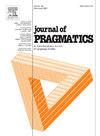“什么,这是什么?”:日本漫画(漫画)中思想表现的互动元素
IF 1.7
1区 文学
0 LANGUAGE & LINGUISTICS
引用次数: 0
摘要
语言通常被认为是天生的对话,但在许多情况下,人们主要使用语言来表达自己,比如在口头思考和说话者自言自语时。虽然语用学关注的是互动情境中的语言使用,但研究非互动情境中的语言使用可以让我们深入了解互动如何塑造语言。考虑到漫画中的语言思想主要是通过视觉而不是语言标记来表示的,它们提供了自由直接思想的独特例子。本研究以日本流行漫画语料库为研究对象,探讨漫画中互动语言的使用,重点关注:1)词性分布;2)感叹词和句子末助词在表达思想和言语中的使用。虽然感叹词在表征言语中更频繁,但在感叹词中,不流畅和填充词在表征思想中明显更频繁。同样,虽然句子末助词在表征言语中出现频率更高,但在表征思想中,自述na和疑问句ka出现频率更高。与之前关于自言自语的研究结果不同,“他人导向的yo”虽然总体上在表征语言中更频繁,但在思想中所占的相对比例要比“ne”大。这些互动元素通常用于悬置互动,作为引导读者通过文本和深化人物的虚构手段。这也表明,应该重新考虑互动本身的概念,以更好地包含单方面的互动,例如在表征思想中观察到的互动。本文章由计算机程序翻译,如有差异,请以英文原文为准。
“Wha, what is this?”: Interactive elements in the representation of thoughts in Japanese manga (comics)
Language is commonly assumed to be inherently dialogic, but there are many situations where people use language primarily to address themselves, as in verbal thoughts and when speakers talk to themselves. While pragmatics focuses on language use in interactive situations, examining non-interactive language use can offer insight into how interaction shapes language. Given that verbal thoughts in comics are primarily indicated visually and not by linguistic markers, they provide unique examples of free direct thoughts. This study investigates interactive language use in comics by examining a corpus of popular Japanese comics, focusing on 1) parts of speech distribution and 2) the use of interjections and sentence final particles compared in represented thoughts and speech. Although interjections were more frequent in represented speech, within interjections, disfluency and fillers were significantly more frequent in represented thoughts. Similarly, although sentence final particles were more frequent in represented speech, the self-directed na and question ka more frequent in represented thoughts. Unlike previous findings on self-talk, other-directed yo, while more frequent in represented speech overall, represented a larger relative proportion than ne in thoughts. These interactive elements were often used in suspended interaction, functioning as fictive devices to move readers through the text and deepen characters. This also suggests that the concept of interaction itself should be reconsidered, to better encompass one-sided interaction such as that observed in represented thoughts.
求助全文
通过发布文献求助,成功后即可免费获取论文全文。
去求助
来源期刊

Journal of Pragmatics
Multiple-
CiteScore
3.90
自引率
18.80%
发文量
219
期刊介绍:
Since 1977, the Journal of Pragmatics has provided a forum for bringing together a wide range of research in pragmatics, including cognitive pragmatics, corpus pragmatics, experimental pragmatics, historical pragmatics, interpersonal pragmatics, multimodal pragmatics, sociopragmatics, theoretical pragmatics and related fields. Our aim is to publish innovative pragmatic scholarship from all perspectives, which contributes to theories of how speakers produce and interpret language in different contexts drawing on attested data from a wide range of languages/cultures in different parts of the world. The Journal of Pragmatics also encourages work that uses attested language data to explore the relationship between pragmatics and neighbouring research areas such as semantics, discourse analysis, conversation analysis and ethnomethodology, interactional linguistics, sociolinguistics, linguistic anthropology, media studies, psychology, sociology, and the philosophy of language. Alongside full-length articles, discussion notes and book reviews, the journal welcomes proposals for high quality special issues in all areas of pragmatics which make a significant contribution to a topical or developing area at the cutting-edge of research.
 求助内容:
求助内容: 应助结果提醒方式:
应助结果提醒方式:


